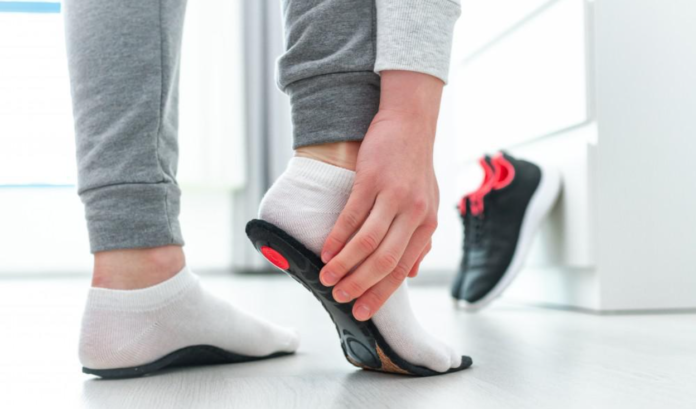When you experience back, hip, or knee pain, it may lead you to experience more than simply agony. It’s likely to make doing necessary tasks and engaging in hobbies you like uncomfortable and difficult.
At Mountain View Foot & Ankle Institute, we know the challenges that chronic pain may create and are here to provide a simple solution – personalized foot orthotics.
Before you assert that your feet are not in pain, remember to check out the custom fit orthotics products.
This includes Custom foot orthotics, also known as orthoses, which are often used to alleviate knee and ankle discomfort caused by foot problems such as:
- Excessively high arches
- Plantar fasciitis
- Arthritis
- Diabetes
- Metatarsalgia
- Bunions
Custom foot orthotics may alter and correct your foot’s movement and function. Orthotics, which are custom-made to fit within your shoe, may alter the distribution of force and offer to cushion and mitigate the impact. Additionally, they might assist in realigning your feet.
Why Custom Orthotics Are Better Than Generic Inserts
Custom orthotics are made to assist specific parts of the foot. They may help alleviate heel discomfort, correct for deformities in the toe joint, and even elevate the arch.
Customization is critical when it comes to orthotics. Unlike mass-produced, generic shoe inserts available at any pharmacy, bespoke orthotics are custom-made for your foot and give support precisely where it is needed. They are specially designed to accommodate your foot’s size and shape.
Due to the unique nature of each foot, any insert that is not custom-fit might create as much discomfort as it is designed to alleviate.
How to tell if you need orthotics
Orthotics may be used as part of a complete treatment plan to address various complaints, most often related to foot, and leg pain and discomfort. Several of the objectives a physician may have for orthotic therapy include the following:
- rectifying foot deformities
- assisting the foot or ankle in performing better
- supporting the ankle
Orthotics are more than a heel pad or shoe insert that you can get at most sporting goods shops. They have highly tailored shoe or heel inserts that are created specifically for your foot. Your doctor would only suggest an orthotic if no other treatment option, such as at-home exercises, has proved successful.
ALL ABOUT KIDNEY CREATININE AND ITS TREATMENT IN AYURVEDA
How custom foot orthotics help with back, hip, and knee pain
Certain foot disorders may put a strain on your lower back and other weight-bearing joints, such as your hips and knees, particularly those that impact the biomechanics of your foot’s functioning, balance, or gait.
Although several disorders may result in this sort of discomfort, the following are the most notable:
- Pronation (inward rolling of the foot)
- Supination (when the foot rolls outward)
- Feet that are flat
- Extremely lofty arches
Consider one of these to demonstrate how a foot problem may have a domino effect on other sections of the body. If your feet roll inwards and pronate naturally, your body weight is distributed along the outside border of your foot.
This unequal weight leads the knees to bend inward toward one another. Because of this knock-knee stance, the femur (thigh bone) enters the hip joint at an abnormal angle, upsetting the pelvic area and resulting in an unstable hip posture. This hip misalignment affects the spine and may place additional pressure on the lower back and therefore knee pain relief products are necessary for a healthy life.
Types of orthotics for feet
Orthotics are available in a range of materials and may be personalized. A physician will create a prescription for an orthotic material depending on the individual’s condition and complaints.
Orthotics come in various materials, ranging from stiff — often composed of carbon fibre or plastic, which is very flexible and soft.
Certain orthotics are complete shoe inserts that resemble the insoles seen in many sporting shoes. Others are a tiny heel implant that fits into the shoe’s rear cup.
Another alternative is ankle-foot orthotics, including a shoe insert and a good part that stretches from the heels upward and across the calf.
Orthotics may be prescribed with braces, other shoe inserts, or taping techniques such as kinesiology taping.
People with foot and ankle issues may benefit from orthotics as part of a complete therapy approach. They aren’t for everyone, or those without health insurance may have to pay for them out of pocket.
If your doctor prescribes an orthotic or a set of orthotics, be sure to inquire about the expected benefits of regular use. To ensure that your custom orthotics fit well and provide you with the most help, we suggest that you get your feet examined by a podiatrist or foot surgeon. Many motion and muscle tests are performed, and gait analysis to select the optimum orthoses for your feet.
After determining what you need, we cast your foot in a stable position and begin creating your custom-fit foot orthotic.
Conclusion
Although they may feel strange at first, personalized foot orthotics may considerably improve hip and knee pain, as well as lower back discomfort. Additionally, there are many health benefits of getting physiotherapy regularly even after being on your feet with custom fit orthotics.











